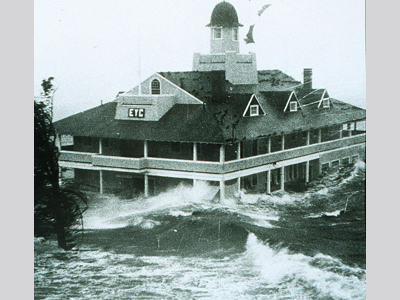Basic Statistics
Dates
Maximum wind speed Minimum pressure Deaths Damage Landfall
August 25- September 1, 1954
185 km/hr (115 mph) 957 mb 68 460 Million U.S. Long Island, NY; Connecticut In late August 1954, Hurricane Carol would become the most powerful storm to strike Southern New England since the Great New England Hurricane of 1938. The system developed from a tropical wave over the northeast Bahamas on August 25, 1954. The wave developed into a tropical depression, and within six hours, the depression strengthened into Tropical Storm Carol and proceeded to move in a northwest direction. The storm intensified into a hurricane on 27 August, 555 km (345 mi) east of Cape Canaveral, FL and maintained Category 2 status with 169 km/h (105 mph) winds for 30 hours before losing some strength off the coast of Georgia. The storm then took a turn to the northeast and regained strength, coming very close to Cape Hatteras, NC, on 30 August. The hurricane began to accelerate north northeastward, moving at a rate of 63 km/h (39 mph). Hurricane Carol strengthened to Category 3 status just prior to making landfall at Point O’ Woods, Long Island, NY on 31 August. The storm quickly crossed the island and made a second landfall at Old Saybrook, CT. Sustained winds between 130-160 km/h (80-100 mph) were experienced over eastern Connecticut, all of Rhode Island and nearly all of eastern Massachusetts. A gust of 217 km/h (135 mph) was recorded at Block Island, RI – the highest ever recorded at that location. After crossing New England, the hurricane dissipated quickly, turned extratropical over southern New Hampshire, and then became completely disorganized over southern Quebec, Canada.
Hurricane Carol caused widespread destruction along the Southern New England coast. Some coastal communities in Rhode Island, from Westerly to Narragansett, were almost completely destroyed as a result of the hurricane’s powerful winds. In addition to strong winds, Hurricane Carol also produced an incredibly high storm surge, the highest of which was experienced in Narragansett Bay, RI and northeastern Buzzards Bay, MA. A surge of 4.4 m (14.4 ft) was measured at Providence, RI, submerging a quarter of the downtown area with 3.7 m (12 ft) of water. New Bedford, MA saw a 14.3 ft (4.4 m) surge. Coastal communities in Connecticut were nearly wiped out in New London, Groton, and Mystic. Rainfall totals, fairly light due to the speed of the storm, were between 51-117 mm (2-5 in), with the highest recordings in the New London, Connecticut area at 152 mm (6 in). In total, over 4,000 homes, 3,500 automobiles and 3,000 boats were destroyed and 65 lives were lost as a result of Hurricane Carol. With damages totaling over $460 million (1954 USD), Hurricane Carol was the costliest natural disaster in U.S. history until Hurricane Diane surpassed it the following year. Fast Facts:
Sources:
Emanuel, Kerry A. Divine Wind. Oxford: Oxford University Press, 2005. Pp. 151, 265. Hurricane Carol. National Weather Service, Boston, MA Office. 2005. Hurricane Histories – Hurricanes Carol and Edna 1954. National Hurricane Center. Hurricane Carol. Wikipedia. 2009. Hurricane Edna.Wikipedia. 2009. Davis, Walter R. “Monthly Weather Review: Hurricanes of 1954.” U.S. Weather Bureau. 1954. Web. New England Hurricane of 1938. Wikipedia. 2009. Web. |


